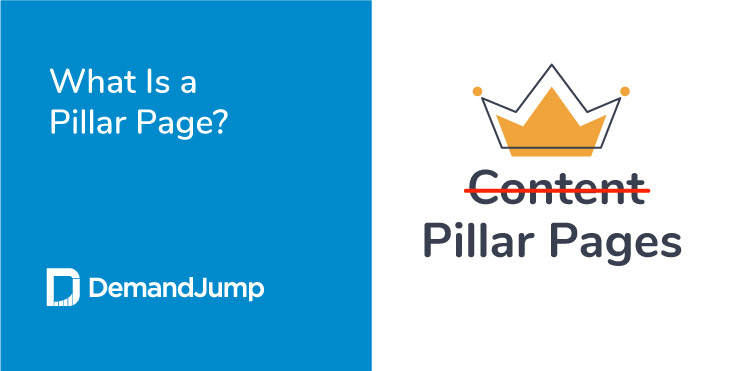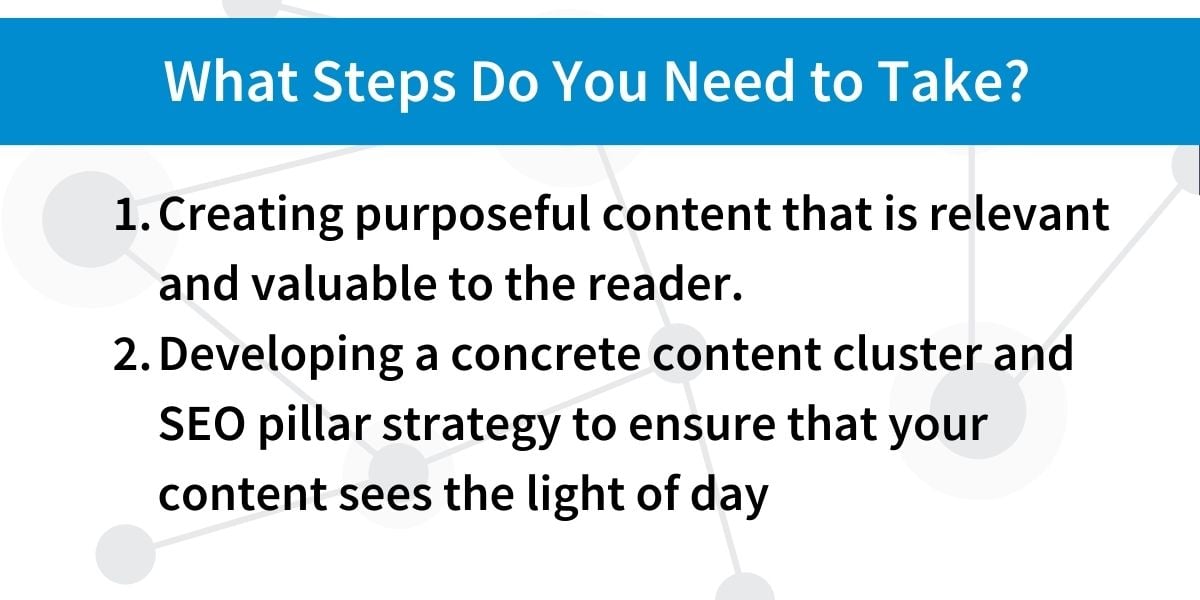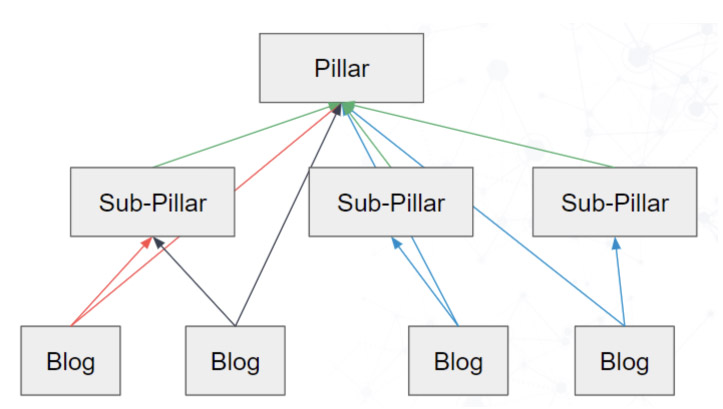What Is a Pillar Page?
February 18, 2022 •Clare Sheehan

We live in a world where content is king. In fact, Internet Live Stats reports that over 7 million blogs are published a day. Unfortunately, not all content is fit to wear a crown, and over 90% of web pages get absolutely no traffic from Google. But for good or for ill, this non-stop production of content is unlikely to slow down any time soon.
In addition to this mammoth avalanche of content production, people’s searching habits have also evolved. Gone are the days of optimizing blog content to rank for long-tail keywords - conversational and precise search queries are primarily what people are entering when they visit Google and other search engines. People want to find exactly what they’re looking for and fast. And search engines are working hard to give people what they want by adjusting their algorithm to view these “conversational searches” as a single thought, rather than individual keywords.
This means that if you want to show up on page 1, the content you create needs to address the maximum amount of searches that relate to the particular subject you want to rank for. So, what steps do you need to take to get your story out there and rise above the noise?
- Creating purposeful content that is relevant and valuable to the reader.
- Developing a concrete content cluster and SEO pillar strategy to ensure that your content sees the light of day.
In this article, we’ll provide you with a few pillar page examples and explain how using content clusters and the pillar page strategy can land you a spot on page 1 of Google.

How Do Pillar Pages Work?
Before you can understand pillar pages, you first need to become acquainted with the concept of SEO Pillar strategy and content clusters. So, what is a content cluster? In the most basic terms, a content cluster is a network of related content. As a collective, each piece of content in a cluster works together to answer every question your audience is searching for. A content cluster is made up of the following:
- Pillar page: Around 3,000 words
- Support pillars: Around 2,000 words
- Blogs: Around 750 words
A pillar page is the main event of the content cluster. Pillar pages serve as an in-depth resource for a particular topic you are an authority on and want to rank for. You then can choose related sub-topics to use for your shorter support pillars and blogs, all of which link back to the main pillar page. This pillar strategy allows you to capture as much traffic as you can from Google by providing a comprehensive and easily accessible network of content for your chosen topic.
Here is the basic layout of the pillar and cluster content strategy:

How to Create a Pillar Page
There are many types of pillar pages, and the specific layout of their content varies depending on the topic they’re covering. For example, an eCommerce pillar page will be drastically different from a SaaS company pillar page. Although there is no one-size-fits-all pillar page outline, there are universal steps everyone needs to take to create effective pillar content.
Step 1: Choose a Topic
When choosing a pillar topic, you need to ensure that your subject is broad enough to generate related support pillars and blog posts. However, you need to steer clear of selecting a topic that is too wide-ranging. Whatever topic you choose for your pillar will ultimately inform the rest of your content cluster. For example, you might write a pillar page about pastry -- a broad topic -- and a piece of cluster content (a support pillar or blog) about croissants -- a more specific keyword within the topic.
Step 2: Identify Your Keywords
To create an effective pillar page, you need to include high-value keywords and questions to drive traffic to your site. Even your pillar title should be based on a high value keyword or question. It is extremely difficult and time-consuming to manually determine which keywords and questions are the best for your overall SEO keyword research strategy. But that’s where DemandJump comes in. Our consumer behavior insights uncover the most important topics, questions, and keywords you need to include in all of your content. DemandJump offers you the following and more:
- A prioritized list of content to create
- The ability to see exactly what your target audience is searching
- The ability to observe what topics you are winning and where there is opportunity
Step 3: Get Organized and Start Writing
We find that it’s best to organize your pillar around the keywords and questions you’ve discovered throughout the SEO keyword research process. Creating an outline using these keywords and queries helps you stay on track and can directly inform the flow of your entire pillar page. Once your pillar page is finished, you can move on to creating your support pillars and blogs. You then link every support pillar and blog back to your original pillar page to create a seamless experience for your readers and help your content rank higher in search engines.
What Makes a Good Pillar Page?
As we stated above, all pillar page content is unique and differs depending on who the audience is, but there are a few pillar page best practices that you should consider.
- Avoid rambling tangents when writing your pillar. It may be tempting since pillar pages are long-form pieces of content, but it is vital that your pillar article remains concise but comprehensive. If you’re struggling, then we suggest using a peer review system. Sharing content with your colleagues for feedback helps trim down the fat and refocus your writing on what really matters.
- If you are writing a pillar then you need to make it abundantly clear that you are an authority on the subject you are covering. All of your research and points need to be helpful, accurate, and properly cited.
- The objective of all pillar pages is to solve a problem for the reader. Avoid the temptation to make a very long-winded sales pitch while still explaining how you are an integral part of solving the problem your readers are experiencing.
- A pillar page is not the same thing as a landing page. When considering the differences between a pillar page vs landing page, think about your reader's context; a landing page is designed to convert traffic, but a pillar page is designed first and foremost to inform.
Write Faster, and Rank Better With DemandJump
After reading this you’re ready to write a stellar pillar, but it would be a shame if no one sees it. With DemandJump’s one-click content outlines and revolutionary keyword research, we can help you reach your key audience in no time. Ready to rise to the top of the search engine results? Get started with a free trial today.
Featured Articles
Categories
- Attribution Tracking (13)
- Channel Optimization (11)
- Consumer Insights (68)
- Content Marketing (251)
- Data Science (8)
- Digital Marketing (6)
- Digital Transformation (26)
- Enterprise (10)
- Lead Generation (14)
- Market Intelligence (8)
- Marketing Analytics (39)
- Marketing Attribution (57)
- Marketing Management (153)
- Marketing Operations (86)
- Organic Search (222)
- Paid Search (52)
- Pillar-Based Marketing (63)
- Programmatic Advertising (9)
- SaaS Content (14)
- SaaS Marketing (29)
- Search Marketing (111)
- SEO Keyword Research (28)
- SEO Pillar (18)
- SEO Strategy (46)
- SMB (5)
- Website Content (12)


